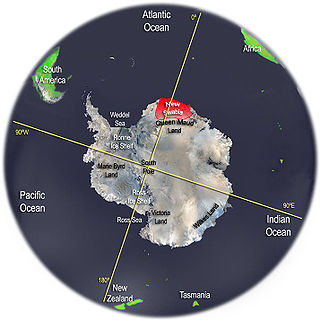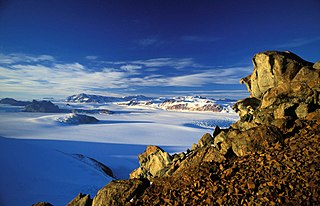
New Swabia was a disputed Antarctic claim by Nazi Germany within the Norwegian territorial claim of Queen Maud Land and is now a cartographic name sometimes given to an area of Antarctica between 20°E and 10°W in Queen Maud Land. New Swabia was explored by Germany in early 1939 and named after that expedition's ship, Schwabenland, itself named after the German region of Swabia.

The Transantarctic Mountains comprise a mountain range of uplifted rock in Antarctica which extend, with some interruptions, across the continent from Cape Adare in northern Victoria Land to Coats Land. These mountains divide East Antarctica and West Antarctica. They include a number of separately named mountain groups, which are often again subdivided into smaller ranges.

Showa Station, sometimes alternately spelled Syowa Station, is a Japanese permanent research station on East Ongul Island in Queen Maud Land, Antarctica. Built in 1957, Showa Station is named for the era in the Japanese calendar during which it was established, the Shōwa period.
Sal, SAL, or S.A.L. may refer to:

Troll Airfield is an airstrip located 6.8 kilometres (4.2 mi) from the research station Troll in Princess Martha Coast in Queen Maud Land, Antarctica. Owned and operated by the Norwegian Polar Institute, it consists of a 3,300-by-100-metre runway on glacial blue ice on the Antarctic ice sheet. The airport is located at 1,232 metres (4,042 ft) above mean sea level and is 235 kilometres (146 mi) from the coast.

Hinode Station is a station on the Yurikamome Line in Minato, Tokyo, Japan. It is numbered "U-04".

Akebono Glacier is a glacier flowing to the coast between Cape Hinode and Akebono Rock in Queen Maud Land. It was mapped from surveys and air photos by the Japanese Antarctic Research Expedition, 1957–1962, who applied the name.

Kita-Hinode Station was a railway station in Asahikawa, Hokkaidō Prefecture, Japan. Its station number is A33.

Queen Maud Land is a roughly 2.7-million-square-kilometre (1.0-million-square-mile) region of Antarctica claimed by Norway as a dependent territory. It borders the claimed British Antarctic Territory 20° west and the Australian Antarctic Territory 45° east. In addition, a small unclaimed area from 1939 was annexed on 12 June 2015. Positioned in East Antarctica, it makes out about one-fifth of the continent, and is named after the Norwegian queen Maud of Wales (1869–1938).

Norway has three dependent territories, all uninhabited and located in the Southern Hemisphere. Bouvet Island (Bouvetøya) is a sub-Antarctic island in the South Atlantic Ocean. Queen Maud Land is a sector of Antarctica which spans between the 20th meridian west and the 45th meridian east. Peter I Island is a volcanic island located 450 kilometres (280 mi) off the coast of Ellsworth Land of continental Antarctica. Svalbard is not formally considered to be a dependency. While the Svalbard Treaty regulates some aspects of that Arctic territory, one article acknowledges that these islands are part of Norway. Similarly, Jan Mayen is recognized as an integral part of the nation. Both are, however, unincorporated areas.
Cape Hinode is a rock cape 3 nautical miles (6 km) west of Akebono Glacier on the coast of Queen Maud Land, Antarctica. The cape and many of its nearby features were mapped and named from surveys and air photos by the Japanese Antarctic Research Expedition, 1957–62. The name Hinode-misaki means "sunrise cape".
Hinode Peak is a small coastal peak, 120 metres (390 ft) high, located 3 nautical miles (6 km) southwest of Cape Hinode on the coast of Queen Maud Land, Antarctica. It was mapped from surveys and air photos by the Japanese Antarctic Research Expedition, 1957–62, and named Hinode-yama.
Maigo Peak is a rocky hill situated 1.5 nautical miles (3 km) east-southeast of Cape Hinode and just west of the Bōhyō Heights on the coast of Queen Maud Land, Antarctica. It was mapped from surveys and air photos by the Japanese Antarctic Research Expedition (JARE), 1957–62; the name "Maigo-yama" was applied by JARE Headquarters in 1973.
Bird Mountain, or similar, may refer to:
Mount Johnson, Johnson Mountain, Johnson Peak, or variation, may refer to:
Witches cauldron or variations may refer to:
This page is based on this
Wikipedia article Text is available under the
CC BY-SA 4.0 license; additional terms may apply.
Images, videos and audio are available under their respective licenses.







